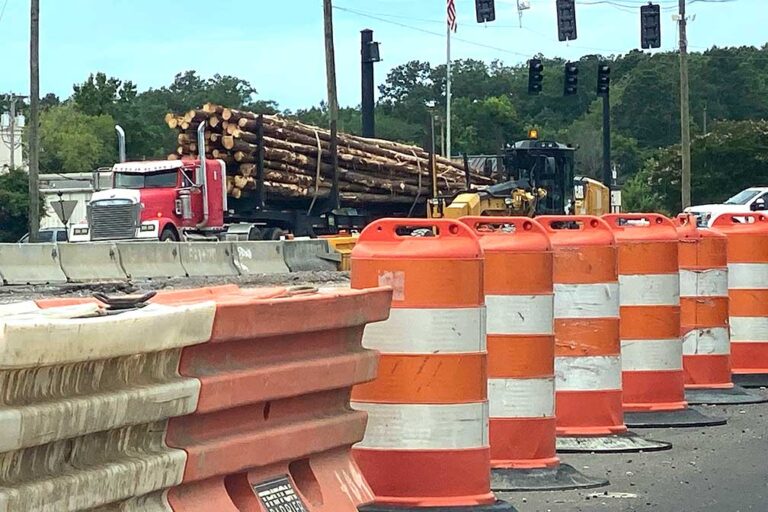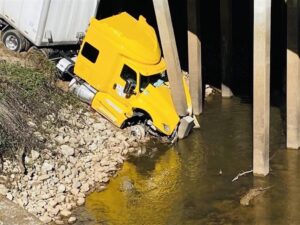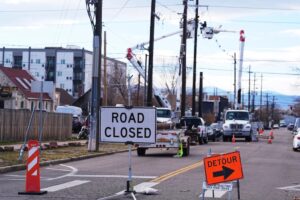Regardless of the calendar, anyone who drives for a living knows that “road construction season” lasts 12 months in many parts of the country.
Thanks to the $1.2 trillion Infrastructure Investment and Jobs Act of 2021 (IIJA) — also known as the Bipartisan Infrastructure Law — there’s still money available for building, expanding or repairing roads and bridges.
The IIJA allocated $110 billion to roads and bridges in addition to funds for rail, broadband, drinking water and other programs. Although it was criticized for excessive spending on “green” projects, the money for roads and bridges was welcome news to the trucking industry.
After all, who can argue the benefits of improving highways and bridges? But there’s a deadline approaching: IIJA provides funding through U.S. fiscal year 2026, which ends Sept. 30, 2026.
So, with cash to be made and an approaching funding deadline, drivers can expect to see orange cones and warning signs blossoming everywhere through the rest of 2025 and well into next year.
Work zone safety challenges
Unfortunately, construction zones present safety challenges of their own, both to drivers and to highway work crews.
When everything goes well in construction zones, lanes are clearly marked, there are plenty of warning signs and lots of time for lanes to merge before lanes end.
• Speed limits
In most cases, there’s a reduced speed limit posted. There’s usually a speed-limit reduction to be observed. It’s important to keep in mind that some drivers — both four-wheelers and 18-wheelers — will ignore these speed limits, creating additional hazards for themselves and others.
• Merging traffic
When lanes are reduced, merging traffic becomes the biggest issue. Drivers of smaller vehicles often don’t want to be stuck behind big trucks; they may have pass through the work zone even more slowly than normal, plus their visibility is impaired by the large vehicle in front of them. To avoid this, some drivers will choose dangerous actions, like passing a big rig when their lane is running out, or cutting back in front of a commercial truck too quickly. Often, a dangerous passing maneuver is followed by a brake application as drivers encounter slowed or stopped traffic ahead.
When lanes are ending, it can be frustrating when other motorists zoom ahead and cut in front. Occasionally, truckers will attempt to block lanes, forcing other vehicles to either merge or wait.
This is illegal in some jurisdictions, and dangerous in every instance. Some states enforce the “zipper” method of merging, where everyone stays in their lane until the merge point and then alternate turns to get into the remaining lane. This method is safer and more efficient than merging far in advance.
Navigating a work zone safely
Once in the construction zone, drivers may become impatient, taking risks in an effort to get through the area faster. Changing lanes across a solid white line is illegal, but because this is rarely enforced, some drivers do it all the time.
Even if there aren’t other motorists to contend with, hazards abound, from rough areas and potholes to rerouted lanes that can be difficult to navigate in an 18-wheeler. Barrels that started out at the edge of a lane can be bumped or pushed into the driving area, making travel even riskier.
Be aware of typical driver behavior.
Knowing the typical behavior of drivers of certain types of vehicles is important.
For instance, drivers of RVs and rental trucks often lack experience in navigating vehicles with larger profiles and may underestimate the vehicles’ width or height. Motorists pulling trailers may have difficulty controlling the “extra passenger.” It’s not unusual for the driver of a larger vehicle who is nervous about a barrier or barrels to move away from the obstacles — sometimes into the adjoining or oncoming lane.
When possible, it’s best to avoid travelling alongside these vehicles.
Be aware of possible distracted drivers.
Distractions abound on the road, particularly in work zones. Vacationing motorists might be trying to ride herd on a group of unruly kids while they drive, or there could be a teen or other inexperienced driver behind the wheel. Other drivers may not have your safety training, or ethic. Phone use or other distractions are everywhere. Construction areas have a way of bringing out the worst in drivers.
Work zones are not all the same
Another hazard to watch for in construction zones are the work crews themselves, as well as the signage and indicators that work is ahead.
Road crews differ from project to project.
DOT-regulated projects often involve federal or state inspectors — but state or local projects with a lower budget may not have as much oversight. Most drivers who’ve spent any time at all on the road can quickly think of instances when lanes were closed with little or no warning, or signage was incorrect or nonexistent, or there were other issues.
Even when warnings are plentiful and done correctly, it takes time for crews to move barrels to another lane or change out signs.
Construction crews differ, too.
In many cases, there is a consistent buffer between moving traffic and machinery and workers. In others, construction activity is taking place right up against the driving lane. Workers have been known to step — or even fall — into traffic lanes. Work trucks can pull into traffic lanes without warning. It’s important to be on the lookout for both machinery and workers when traveling through construction zones.
Avoid work zones
One way to guarantee construction zone safety is to avoid them altogether — but that’s often easier said than done. A short detour around a congested area can save time, but taking another route entirely can add time and miles to your trip, increasing your cost of operation, too.
If you’re negotiating rates with a customer, carrier or broker, it’s a good idea to check road conditions before you bid. If you’ll need extra miles to avoid a construction area, you can include them in your bid.
The Federal Highway Administration’s National Traffic and Road Closure website contains links to each state’s DOT as well as links to the National Weather Service and to SafeTravelUSA, another road construction site. Checking these while planning a trip could result in a safer, more relaxing drive. Some have traffic cameras posted to let you see how traffic is flowing (or not flowing) through the construction.
Phone apps such as Waze and Trucker Path allow users to input road condition data, so you get the most current information. GPS systems can also provide construction updates.
No website, app or GPS unit is foolproof, however. It’s best to check two or more before departure — and then use an app or GPS that can alert you to trouble. Remember, too, that some apps and GPS units don’t account for large vehicles and could route you to areas where trucks are restricted or a low clearance situation exists.
After planning your route and considering the alternatives, you won’t be able to avoid every construction zone. Staying patient and keeping an eye out for hazards will help you through them safely.
Cliff Abbott is an experienced commercial vehicle driver and owner-operator who still holds a CDL in his home state of Alabama. In nearly 40 years in trucking, he’s been an instructor and trainer and has managed safety and recruiting operations for several carriers. Having never lost his love of the road, Cliff has written a book and hundreds of songs and has been writing for The Trucker for more than a decade.















